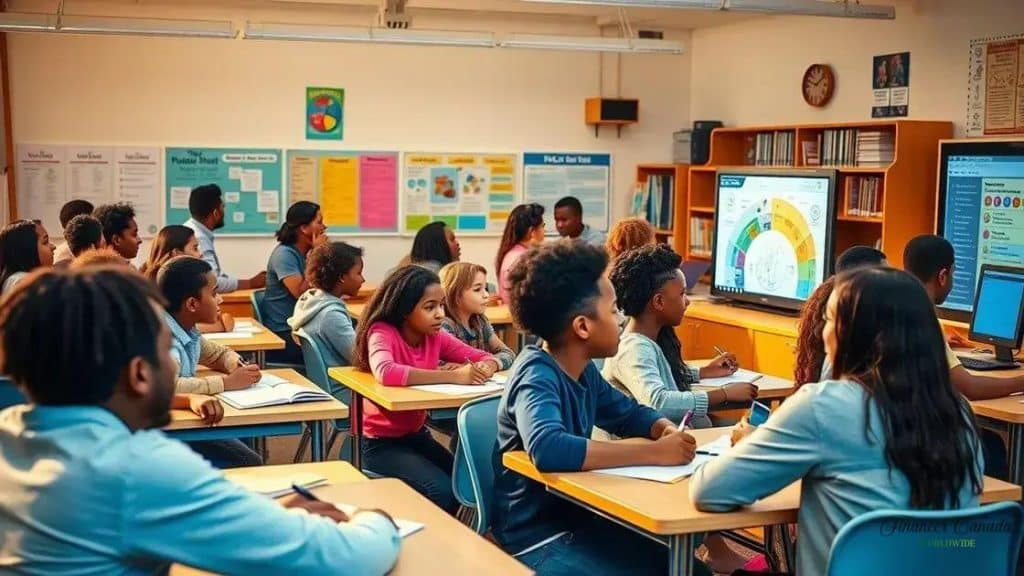The rise of hybrid learning environments: a new approach

The rise of hybrid learning environments combines in-person and online education, enhancing engagement, personalizing learning, and integrating advanced technologies to better prepare students for the future.
The rise of hybrid learning environments is changing how we approach education today. Wondering how this mix of in-person and online learning shapes the future of classrooms? Let’s dive in.
Understanding hybrid learning environments
Understanding hybrid learning environments is essential for educators and students alike. These settings blend traditional in-person learning with online education, creating a more flexible and accessible approach to teaching. It’s important to grasp how this model can enhance the educational experience.
What is Hybrid Learning?
Hybrid learning combines face-to-face interactions with digital resources. This method offers various ways for students to engage with material, catering to different learning styles.
Key Characteristics of Hybrid Learning
- Flexibility: Students can choose when and where to learn.
- Personalization: Learning can be tailored to meet individual student needs.
- Technology Integration: Use of digital tools enhances engagement.
This flexibility allows learners to progress at their own pace, which can lead to greater understanding and retention of information. For instance, online discussions and interactive activities can deepen comprehension and foster collaboration among peers.
Benefits of Hybrid Learning Environments
The advantages of hybrid learning are numerous. Students experience increased motivation as they have control over their learning journey. This model also encourages self-discipline, as learners must manage their time effectively. Moreover, teachers can utilize diverse assessment strategies to meet various learning objectives, providing a more rounded educational experience.
By utilizing hybrid learning environments, educators can tap into a wealth of resources and tools that traditional classrooms cannot offer. This proactive approach paves the way for a more engaging and effective learning atmosphere.
Benefits of hybrid learning for students

The benefits of hybrid learning for students are significant and transformative. This educational approach provides a unique opportunity for learners to engage in both traditional and online formats. With this flexibility, students can choose the method that best fits their learning style.
Enhanced Engagement
In hybrid environments, students often show increased engagement. The blend of online resources and face-to-face interactions keeps learners motivated. They can participate in discussions, watch videos, and access materials at their convenience.
- Interactive Learning: Activities are often more interactive, allowing for better participation.
- Diverse Resources: Students access a wider range of educational tools.
- Flexibility: Learners can study from anywhere, making education more accessible.
This format encourages students to take responsibility for their own learning. They can set their own pace and revisit challenging materials as needed. Furthermore, hybrid learning promotes collaboration among peers, allowing them to work together through various digital platforms.
Improved Skill Development
Students in hybrid learning environments also develop essential skills that are vital for their future careers. These include digital literacy and critical thinking. As they navigate online platforms, learners build confidence in using technology.
Moreover, hybrid settings encourage students to develop self-discipline. With more control over their learning schedules, they learn to manage their time effectively. This experience prepares them for more independence in higher education and the workforce.
Key technologies enabling hybrid education
Key technologies enabling hybrid education play a vital role in how instructors and students engage with learning materials. These tools create a seamless experience, blending in-person and online education. By leveraging the right technologies, educators can enhance the learning environment for all students.
Learning Management Systems (LMS)
One of the most essential tools in hybrid learning is the Learning Management System (LMS). This platform allows teachers to share resources, track student progress, and facilitate communication. Students can access materials anytime, making it easier to participate in their education.
- Course Organization: LMSs help organize course materials efficiently.
- Progress Tracking: Instructors can monitor student performance and provide timely feedback.
- Communication Tools: Allows easy interaction between students and teachers.
By using an LMS, both teachers and students benefit from a well-structured educational experience that fosters collaboration and accountability.
Video Conferencing Tools
Another critical technology is video conferencing tools. These platforms enable real-time interactions, creating a dynamic classroom environment even when students are not physically present. Features such as screen sharing and breakout rooms enhance collaboration among peers.
Students can engage in discussions, participate in group projects, and receive immediate support from instructors. Furthermore, video conferencing tools help break down geographical barriers, allowing diverse groups of students to connect and learn from one another.
Interactive Learning Tools
Interactive learning tools, such as quizzes and polling applications, enhance student engagement in hybrid classrooms. These technologies invite participation and make learning more enjoyable. They also provide instant feedback, helping students gauge their understanding of the subject matter.
With the integration of these technologies into hybrid education, students experience richer learning environments. They can access a variety of resources that boost understanding and retention while preparing them for a technology-driven world.
Challenges of implementing hybrid learning

Implementing hybrid learning comes with various challenges that educators and institutions must navigate. While this model offers many benefits, it also creates obstacles that can impact the learning experience.
Technical Difficulties
One major challenge is the technical difficulties that can arise. Not all students have access to reliable devices or high-speed internet. This can hinder their ability to participate fully in online aspects of their education.
- Device Availability: Students may not have their own computers or tablets.
- Internet Connectivity: Reliable internet access is crucial for effective hybrid learning.
- Software Issues: Technical problems with platforms can disrupt lessons.
These barriers can lead to feelings of frustration among students, limiting their engagement and success.
Teacher Preparation
Teachers also face challenges when adapting to hybrid models. Many may not be fully proficient in using technology or managing both in-person and online students simultaneously. Training and support are essential for teachers to feel confident in their roles.
As educators juggle in-person instruction while addressing online needs, they may struggle to create a cohesive learning environment. It’s important for schools to provide resources that equip teachers with necessary skills and techniques.
Classroom Management
Classroom management becomes more complex in a hybrid setting. Teachers need to monitor both in-person and virtual students simultaneously. This can lead to a divided focus, making it challenging to maintain engagement.
Establishing rules and expectations for both groups is crucial. Teachers may also require additional strategies to promote participation among remote learners, ensuring that they feel included and valued.
Despite these challenges, overcoming them can enhance the effectiveness of hybrid learning. By identifying and addressing obstacles early on, schools can create a better educational experience for everyone involved.
The future of hybrid learning in schools
The future of hybrid learning in schools is bright and full of potential. As educational institutions adapt to new technologies and changing student needs, hybrid models are likely to evolve further. These changes aim to create a more engaging and effective learning environment.
Integration of Advanced Technologies
In the coming years, we can expect a greater integration of advanced technologies in hybrid learning. Tools like artificial intelligence and virtual reality will enhance student experiences. For instance, AI tools can provide personalized learning paths, while virtual reality can immerse students in interactive experiences.
- Adaptive Learning: Programs can adjust content based on student performance.
- Immersive Experiences: VR can simulate real-world scenarios for deeper learning.
- Data Analytics: Schools can track progress and tailor instruction more effectively.
This incorporation of technology not only engages students but also helps teachers better understand and support individual learning needs.
Focus on Student-Centered Learning
Another trend in the future of hybrid learning is the shift towards student-centered approaches. Educators are recognizing the importance of engagement and participation, which drives student achievement. In a hybrid model, students can take more control of their education, allowing them to pursue interests and explore subjects deeply.
This model encourages critical thinking, creativity, and collaboration. Students will likely work on more project-based learning, where they can apply their knowledge to real-world problems, further enhancing their understanding and retention.
Collaboration Between Educators
The future will also see increased collaboration among educators. This teamwork allows for sharing best practices and developing new teaching strategies. Teachers can exchange resources and support each other in implementing hybrid methods effectively.
As institutions continue to evolve, the focus will be on creating a supportive community that values innovative teaching. This collaboration can also lead to more consistent standards and practices across various subjects and grade levels.
Ultimately, the outlook for hybrid learning in schools is promising as technology advances and teaching methodologies adapt. By prioritizing student engagement and teacher collaboration, schools can create effective learning environments that prepare students for the future.
In conclusion, the future of hybrid learning is full of opportunities. As technology advances and teaching methods adapt, schools will be able to create more engaging and personalized learning experiences. Integrating advanced technologies, focusing on student-centered learning, and fostering collaboration among educators will be key in this journey. By addressing current challenges, schools can ensure that all students thrive in a hybrid environment.
FAQ – Frequently Asked Questions about Hybrid Learning Environments
What is a hybrid learning environment?
A hybrid learning environment combines traditional in-person classroom experiences with online learning, allowing flexibility and access to diverse educational resources.
What are the main benefits of hybrid learning for students?
Hybrid learning offers enhanced engagement, personalized learning experiences, and the development of critical skills such as self-discipline and digital literacy.
What technologies are key to successful hybrid learning?
Key technologies include Learning Management Systems (LMS), video conferencing tools, and interactive learning applications that facilitate communication and collaboration.
What challenges do schools face in implementing hybrid learning?
Challenges include technical difficulties, the need for teacher training, and effective classroom management when accommodating both in-person and online students.





